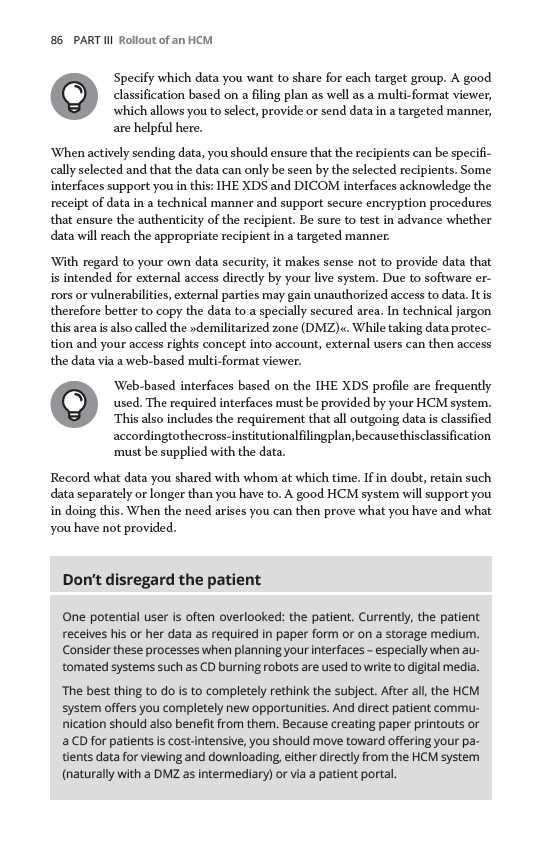
86 PART III Rollout of an HCM
Specify which data you want to share for each target group. A good
classification based on a filing plan as well as a multi-format viewer,
which allows you to select, provide or send data in a targeted manner,
are helpful here.
When actively sending data, you should ensure that the recipients can be specifically
selected and that the data can only be seen by the selected recipients. Some
interfaces support you in this: IHE XDS and DICOM interfaces acknowledge the
receipt of data in a technical manner and support secure encryption procedures
that ensure the authenticity of the recipient. Be sure to test in advance whether
data will reach the appropriate recipient in a targeted manner.
With regard to your own data security, it makes sense not to provide data that
is intended for external access directly by your live system. Due to software errors
or vulnerabilities, external parties may gain unauthorized access to data. It is
therefore better to copy the data to a specially secured area. In technical jargon
this area is also called the »demilitarized zone (DMZ)«. While taking data protection
and your access rights concept into account, external users can then access
the data via a web-based multi-format viewer.
Web-based interfaces based on the IHE XDS profile are frequently
used. The required interfaces must be provided by your HCM system.
This also includes the requirement that all outgoing data is classified
according to the cross-institutional filing plan, because this classification
must be supplied with the data.
Record what data you shared with whom at which time. If in doubt, retain such
data separately or longer than you have to. A good HCM system will support you
in doing this. When the need arises you can then prove what you have and what
you have not provided.
Don’t disregard the patient
One potential user is often overlooked: the patient. Currently, the patient
receives his or her data as required in paper form or on a storage medium.
Consider these processes when planning your interfaces – especially when automated
systems such as CD burning robots are used to write to digital media.
The best thing to do is to completely rethink the subject. After all, the HCM
system offers you completely new opportunities. And direct patient communication
should also benefit from them. Because creating paper printouts or
a CD for patients is cost-intensive, you should move toward offering your patients
data for viewing and downloading, either directly from the HCM system
(naturally with a DMZ as intermediary) or via a patient portal.